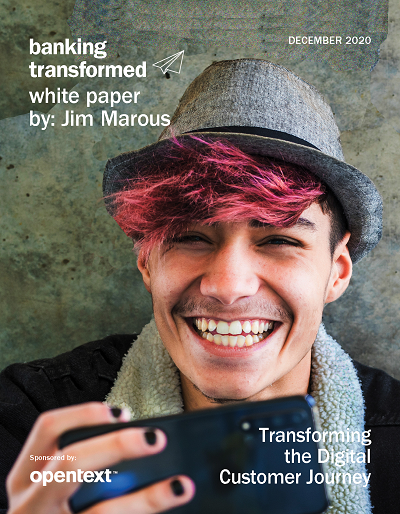Transforming the Digital Customer Journey White Paper
White Paper
Jim Marous
December 2020
: DBR 274
30 pages, 11 tables/charts
Download Printable Version of this page
The impact of the pandemic on consumer expectations was to highlight the importance of digital channels, easy engagement, personalized content, and proactive recommendations. In 2021, ‘being digital’ will not be enough. Consumers will choose their financial institution partner of choice based on the experiences provided.
The challenge for banks and credit unions will be to simplify digital functionality across the entire customer journey, providing personalized, contextual and scalable communication in real time. Investment in digital transformation and customer experiences will need to occur at a time of razor-thin margins and heightened competition.
Customer experiences will need a foundation of data and advanced analytics, deployed across the organization with a uniform view of the customer. Knowing the customer will no longer be adequate. Going forward, the customer will expect ongoing proof that you not only know them, but understand their needs and are willing to invest in their relationship and loyalty.
Transforming the customer journey begins with top level commitment to both an improved data and analytic maturity as well as an overarching focus on the customer experience. Just as importantly, there must me a commitment to deploying insights across the organization with key performance indicators (KPIs) and the measurement of results. At the center of these efforts will be focus on a customer’s end-to-end experience instead of transactional touchpoints in the relationship.
The rush to transform the digital customer experience can result in a bias for technological solutions. As found during the COVID crisis, consumers do not want to relinquish humanization for some interactions. Especially when interactions are new or complex, the personal touch is still viewed as an important differentiator. Consumers must be provided the option of how to engage.
Improving customer experiences across the relationship journey is not a linear process. Banks and credit unions should work on those engagements with the most friction that also have a scale to provide a significant value to the customer and financial institution when transformed. In other words, focus on the areas that the consumer will value the most.
Increasing the value of the transformation over time will require regularly going back to the drawing board and maintaining patience and a mind-set of always pushing for more in the interest of the customer. This is why top-level support is needed. Not every initiative will succeed or bring the value projected.
According to McKinsey, “A continuous-improvement regimen can help foster a superior customer-experience mind-set. One way is at the front line, with employees closing the loop with customers on direct feedback, then using those insights to change the way the process is designed. A second benefit accrues from continuously improving service design.”
Constantly creating feedback loops and actions, rather than simply reporting metrics, reinforces the ongoing commitment to the customer. By transforming customer experience journeys, financial institutions can achieve an ongoing competitive advantage.
Transforming the Digital Customer Journey White Paper
Advanced Analytics, AI, Analytics, Artificial Intelligence, Bank, Banking, Big Data, Credit Union, CRM, Customer Experience, CX, Digital Banking, Digital Lending, Digital Marketing, Digital Transformation, Engagement, Fintech, Innovation, Marketing, Mobile Banking, Payments, Personalization, Technology, Trends, Voice Banking, Voice-First

